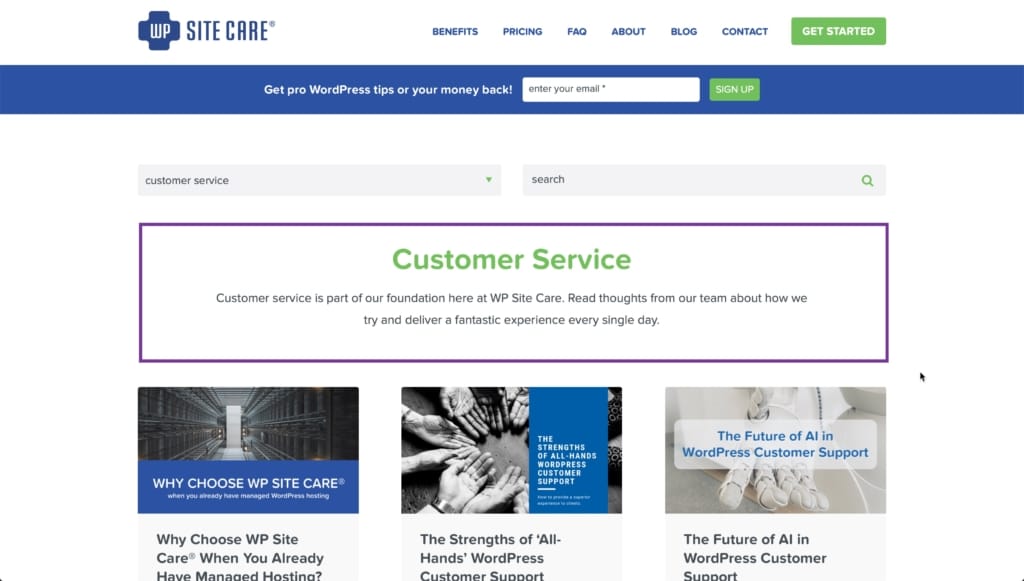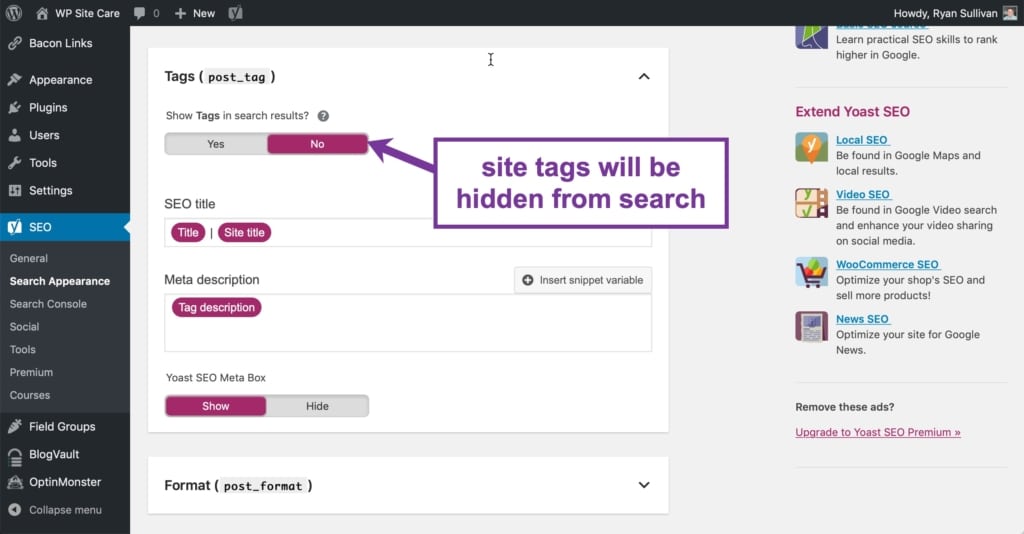We want to help you get your blog SEO right, so let’s go over WordPress categories vs tags.
When handled properly, WordPress can be a fantastic platform for creating SEO content that both Google and users will love. One of the great things about WordPress is that storing your content in a relational database allows you to create logical groups of content. In a standard WordPress website, this grouping is done through the “category” and “tag” taxonomies. Taxonomy is one of those words that most people never hear or use. Basically, a taxonomy is a way to group things together. (There are other taxonomies as well, but they’re less commonly used).
When it comes to categories vs tags, they may seem fairly similar, especially in how they’re displayed and used on a website, but they have very distinct uses. Adhering to their intended use will not only create a better experience for your readers, it’ll also give search engines some really important context which will undoubtedly help you boost those search rankings. Now, let’s break down categories vs tags.
Categories vs Tags: How Do I Know Which One to Use?
Categories
As the name implies, WordPress categories are used to create groups of content that fit the primary topics of your site. Blog posts should clearly fit into a single category. In some super rare cases it may be appropriate for a post to fit two categories, but this is definitely the exception rather than the rule.
Remember the game you played as a kid where you’d put blocks though those incredibly frustrating slots in a box? Just me? Well if that game were your blog, triangle, circle, and square should be your categories. If you bang away with the hammer long enough, you can probably get the circle through the square, but it doesn’t actually fit. Don’t fall victim of trying to force your blog posts into multiple categories. It’s probably result in a broken toy and a crying sister. Or something…
Enough kids games. Let’s use a food blogger as an actual example. Let’s say the food blogger publishes meal recipes. They might have the following categories:
- Breakfast
- Lunch
- Dinner
Because breakfast, lunch, and dinner are distinct meals (although technically breakfast is appropriate at any time), most recipes will apply to a single category.
More In-Depth Category Organization for Niches

What about a more robust example where as a food blogger you want to specialize in one niche area, like desserts, for example?
You’ll need more than one “Desserts” category to appease your readers and search engines, so how do you go about breaking things down at that point? Do you create new categories for every ingredient? That seems excessive and not particularly useful for most readers.

Think back to taxonomies and creating logical groupings. For a food blogger focusing on desserts, how about creating buckets of related sweets that can be more granular, but create smart silos for establishing a strong skeleton for your website.
Here’s an example list of categories for a dessert food blogger:
- Cakes
- Cookies
- Cupcakes
- Pies
- Pastries
- Baking Tips
You can see that there’s definitely room for sub-genres and more specificity as a search engine or human digs deeper, but it’s not so broad that there’s confusion about what to expect in each of those categories.
WordPress Categories & SEO
It’s important to note that the examples above are intended to show how categories should be used for organizational purposes only. In practice, the process of choosing categories is critical for SEO, and should be closely linked with the site’s SEO strategy. Generally speaking a site with blog content that fits neatly in 6-10 keyword focused categories will likely deliver better search engine ranking for those terms than a site with a bunch of categories that may or may not be related to targeted keywords.
If you’re running a blog and are using 30 categories, it’s time to either evaluate your content organization (are you shoving squares into circles?), or your blog itself. It’s quite possible that the WordPress categories you’re using for your blog are a direction reflection of a lack of focus in what you’re writing about, and Google makes it a lot harder for sites with scattered content to rise to the top.
Category Archives
Management of category archives, specifically indexing content properly, is critical to SEO. WordPress’ default category archive template, a simple chronological list of of posts within a category, is not properly optimized for SEO, but there are some things that can be done to help.
Include a description of each category on its archive page. A static paragraph or two describing the content in the category will provide context for visitors and search engines. When you create a category for the first time, a description can be included then. You can also add descriptions at any time by going to Posts –> Categories in your WordPress dashboard and editing individual categories there:
Here’s an example of how we have our Customer Service category configured in the backend of WordPress

And you can see how that manifests itself on the front end of our website

If you’re comfortable with editing your theme files, and your WordPress theme doesn’t include the category description already, the description can be easily added to the archive template with the following code:
echowpautop( term_description() );
If your theme doesn’t display these descriptions by default, and you’d like to have them on your site, you can contact us anytime to take care of that for you.
Google used to have trouble indexing or directing users to the proper subpage in category archives (eg https://website.com/category/breakfast/8/, where 8 is the 8th page of an archive.
However, Google has gotten much better at that now so it’s no longer necessary to explicitly noindex category archive subpages in Yoast SEO. Here’s the advisement from Yoast directly when they removed this feature from the plugin
Since Google has gotten much better at working with paginated series, we’ve removed the feature that allows noindexing subpages of archives. According to Joost de Valk, the reasoning behind this is simple: “
The “noindex subpages” feature is gone from Yoast SEO https://yoast.com/yoast-seo-6-3/rel="next"andrel="prev"make sure Google sends people to the first page in a paginated series. There is one catch: sometimes it will send people to a specific page in the series, but that’s when that page is the best match for their query. This, therefore, should be better for the searcher. Noindexing all these pages leads to a lower amount of crawls for them (source), which subsequently leads to lower amounts of crawls for older articles, which is not a good idea on most sites.”
Tags
While categories are intended to create logical groups of content, tags are best used to create groups of content that apply to multiple categories. That being the case, posts will often have multiple tags applied to them. Using the block game as an analogy again, tags are equivalent to the color of the blocks. The color doesn’t have any impact on which slot the block will fit through.
Here are some possible tags that the food blogger might use:
- Bacon
- Quinoa
- Quick Bake
Ingredients or dietary restrictions would be excellent tags for a food blogger whose categories focus on meal recipes, because they’re common to all types of recipes. This structure allows readers who, for example, have a particular affinity for bacon to find recipes for every meal type that include it (and who wouldn’t want that?).
Tags & SEO
The SEO strategy for tags will vary from site to site, but in most cases it’s advisable to noindex tag archives.
Again, the WordPress SEO plugin makes this super easy:

WordPress tags are important because like we mentioned before, they give people the ability to navigate your site and quickly get to exactly what they want to find.
That said, because tags generally aren’t keyword focused, including them in the site index will dilute the site’s keyword density. Using the food blog example above, if a site was trying to rank for specific meal recipes, it probably wouldn’t be advisable to have search engines index archives for ingredients or dietary restrictions. Additionally, because the same tags will be applied to many posts, separate tag archives will often contain very similar posts, and as a group will likely have low relevancy to the keywords the site is actually trying to rank for.
Hopefully that helps debunk some of the mystery of WordPress categories vs tags, and how to work with them. As always, if you have questions about whether to use categories vs tags, feel free to hit us up in the comments. And if you’d rather have a team handle the technical side for you, investing in wordpress support & maintenance ensures your site stays optimized, secure, and organized while you focus on creating great content.
Have you committed any content organization sins?
Need help sorting them out? Get in touch and our content strategy team can help you out.




21 responses to “WordPress Categories vs Tags: How Do I Use Them on My Blog?”
This is so helpful, Matt. Thank you. So let’s say your categories are a mess and you want to change them. I read somewhere that you shouldn’t delete the categories you’re currently using, but rather add new categories and just take everything out of the old categories. I forget what the rationale was, but I think it was SEO-related. Do you agree with this suggestion, or would you recommend deleting the old categories?
Hey Annemarie,
Matt’s on vacation for a few days so I figured I’d jump in 🙂 This is a question that can be a little bit tricky, mainly because if Google holds a certain category in high regard, you probably wouldn’t want to delete it outright. A proper redirect would be a better answer.
That said, if you have several categories that you don’t plan to do anything with, it doesn’t really make much sense to keep them around either. One plugin that we should probably add to the post is the Term Management Tools plugin https://wordpress.org/plugins/term-management-tools/
That plugin will let you more easily merge categories and will speed up your organization. If you questions about a specific category(ies) on your site that you’d like to get rid of, you can shoot us a quick email to see if there are any precautionary measures that should be taken.
That was the long way around, but hopefully it helps 🙂
Thanks for this great information!
Would you say that it’s okay to use sub-categories to reorganize my blog as well?
For example, if I posted a chicken recipe, I’d like it to go under my ‘recipe’ category, but under my ‘main dish’ sub-category, and then could I use ‘poultry’ as a tag nested under *those* to organize it even more?
Thanks!
Kelly
Thanks Kelly, I’m glad you found it helpful!
For strictly organizational purposes, sub-categories are fine. That being said, I would generally try to avoid them myself for two reasons, both related to SEO:
A) I really believe in having a small handful of categories that are very close to (if not exactly the same as) the keywords being targeted by the site.
B) The majority of posts should clearly clearly fit into a single category.
Following those principles will help ensure that content on the site is very focused (which Google loves), and that category archives have little to no duplicate content (which Google definitely does not love).
If the site is targeting the “Main Dish,” I’d drop the “Recipes” category entirely, and implement the appropriate redirects. If the site is targeting “Recipes,” I would create a “Main Dish” tag. One thing to note here is that “Recipes” and “Main Dish” are general, highly competitive terms, so it would probably be fairly tough to rank for them.
Ingredients are generally a great use of tags, so a “Poultry” tag would be a good choice in either scenario.
I hope that helps! 🙂
Awesome explanation! Categories versus tags is one of those distinctions that’s often not clear to beginners. Or novices. Sure took me long enough to figure out.
I do have one small point of contention. Categories (at least in WP) are also a powerful content management tool. For example, on my own sites, everything gets thrown into one category that fits its content, but also, potentially, into a “Featured” category which gets precedence on the homepage, or a “Favorites” category, which reposts (at long intervals) particularly popular posts. Rarely both. I guess that’s more of an advanced or niche use, so it makes sense not to include it in this basic article. Still, it’s worth noting that it’s one of the easiest ways to make use of many plugins.
Anyway, like I said, great article, perfect for any beginner WordPress user, thanks!
Thanks for the feedback Connor!
Thanks for a great post. I’ve wondered how categories might look for SEO and your post has gone a long way to answering my questions. I was concerned if all posts were indexed that archive pages for tags or categories would look like duplicate content, is that not the case? On a similar note, how about having one post in more than one category, is that bad or neutral?
Thank you for the informative post about categories and tags. I was really confused about these two. Now I know what’s the difference between categories and tags and how to use them properly. Thank you!
Hi, I want to set up a medicinal plants website, and I need advice how to organize the content. Each plant has many medicinal uses and each medical problem has a list of plants that you could use to treat it.
What would be the best way to present this information? would I use categories and tags? if so how exactly would that work, or do I need to look at a plugin like https://wordpress.org/plugins/posts-to-posts/ what do you recommend as the best approach.
Thanks for any help
David
This post just clarified my confusion between using tags and properly optimizing them 🙂 Thanks A lot.
I have a blog about architecture. When I post, I normally check the boxes for five or six categories and list 8 to 10 tags. My assumption was to best describe my post in the broad sense (categories, however many apply) and to use as many specifics as tags to describe the post’s content narrowly – such as listing most proper names or websites mentioned, etc.
Am I going about it all wrong? Should I just check one or two boxes that best categorize each post, and then add only a few more tags to describe it?
Can I change just by doing that? Or do all the categories and tags I’ve used in all my prior posts add up to something that isn’t going to be changed just by starting to do it the right way?
Hey David, thanks for stopping by.
I’d recommend choosing one category per article, and then as many descriptive tags as you’d like.
This does a few different things. 1) It helps keep category archives more focused, and you don’t end up with the same article in several different places, and 2) it helps readers really drill down into singular and more focused topics, which is good for user experience and navigating the site.
Hope that helps!
Nice post, Matt!
I was advised to use categories and tags to avoid cannibalization.
I’d like to know your opinion about it. Do you mind?
Let me detail my case a little bit.
I’m creating a lot of articles with long tail keywords, but to beginning of each long-tail keyword has the same short-tail keyword. And maybe I’m been penalized for that.
Let’s take a simple common example:
– how to make money
– how to make money online
– how to make money with facebook
– how to make money with youtube
– how to make money with blog
…and so on.
I have different sites, so different subjects, but the problem is the same.
I do have a main category calling something like that “how to make money”.
So, these are my problems:
1. URL: I just use the “postname” in the url, no categories. My url postname for each article used to be “how-to-make-money-‘last_words’”. So the base is always the same “how-to-make-money”. Should I start showing the category_name at the url and remove the “how-to-make-money” from the post_name’ slug?
2. Should I use the tags to represent the “internet”, “facebook”, “youtube” and so on?
3. If I do that, how am I supposed to call the post slug? Anything without using the words “how” “make” “money” “facebook”, or could I repeat at least the word that is already a tag, in this case, “facebook”?
4. Can’t I use “How to Make Money …” in the title of each article? So I should use something similar to that, but not equal, like “Generating Money With Your Facebook”?
Sorry about all these questions, but this topic (cannibalization) is messing with my mind and I need to restructure my blog, but I’m not sure how to do it right.
Hope you can help me.
Thanks a lot!
This was really good help, especially for those beginning to write and publish their own blogs. Thanks a lot!
That definitely helps. Should a tag description be shorter than a category description? Maybe one to two sentences?
If categories have a hierarchy, then what prevents is from using the categories and not the tags at all . The tags could be the sub trees of a main category
For example, a post is entitled “How to Travel to New York on a Budget with Family” Should I categorize it under “Travel”, “Finances” or “Family”?
Thanks in advance.
I was doing it wrong =\
Sad for this and happy for finding your post.
Thanks!!!
Hi there,
I work for a gluten free recipe blog and I’m wondering if “gluten free” “recipes” or “gluten free recipes” should be included in the tags since nearly every blog post would have these tags.
Also, we have the recipes broken down by category – Breakfast, Main Dishes, etc. and I’m getting the idea from this post and others I’ve read that we wouldn’t want to have “Breakfast” and “Main Dishes” as categories and tags, so I’m planning on removing them as tags. Is that the right way to go?
Thanks!
Fantástico post, Matt!
Pesquisando online e em cursos cheguei a conclusão de que é importante e deveria usar categorias e tags para evitar a canibalização.
Eu gostaria de saber sua opinião sobre isso. Você se importa?
O que pode me indicar?
Gratidão e desde já parabéns pelo belo trabalho.
Gratidão mesmo!
Hi Matt,
It was a great informative article but the my question is about the importance of tags, as compared to categories I think tags can be more useful in website search, If your interlinking is good and the tags you have used are appropriate it will surely help you to reach out more searches.
Please let me know if I am wrong.
Thanks